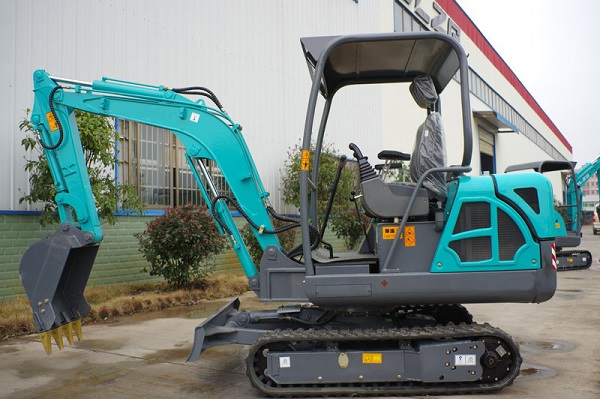- info@hightoptools.com
- Monday - Sunday 9.00 - 18.00
WhatsApp: +86 18162052962

With the widespread application of monitoring systems on small excavators, the requirements for human-machine-information interaction are getting higher and higher. In addition to the functions of the modern small excavator electronic monitoring system, its design rationality, versatility, and ease of operation need to be considered and discussed ingeniously. The relevant technical points need to be processed in detail, otherwise it will be applied In the process, you will find that there are various application problems. A good electronic monitoring system architecture can make it convenient for developers to expand new functions, make it easy for operators to operate, make it easy for maintenance personnel to locate abnormalities and errors, and enable small excavator owners to instantly understand the use of their equipment.
Functional requirements of modern monitoring systems
Modern monitoring systems generally consist of signal input parts (such as analog signals, switch signals, etc.), signal processing parts, controllers, monitors and control actuators. Due to the harsh working environment, complex working conditions, high maintenance frequency, and inevitable failures of hydraulic small excavators, the monitoring system requires the following functions:
(1) Data collection function
The system needs to collect the working status signal of the hydraulic small excavator. For example: engine coolant temperature, hydraulic oil humidity, fuel level, air filter alarm switch, battery electric skin, preheating signal, etc. The signal types are mainly analog signal, switch signal, PWM signal, etc.
(2) Bus communication function
As a part of the electronic control system in mechatronics, the monitoring system needs to interact with the main controller and GPS remote monitoring platform. The main controller and GPS communication module of modern electronic control all adopt the bus control system, and the monitoring system also needs to have the bus communication function.
(3) Human-computer interaction function
The monitoring system enables the operator to view the working information of the system through the display device. The display device should have a better viewing angle and adjustable brightness, adapt to the needs of different lighting environments, and be able to display alarm indication information. The display interface is beautiful and adaptable. Strong. The displayed interface requires a visually invisible interface refresh process, and the displayed instrument panel requires the pointer to indicate normal. Through the language navigation, the language suitable for the operator can be selected to facilitate the operation of the small excavator. The monitoring system should have a key input function, so that the operator can perform various control operations through the keys, such as enabling the small excavator to switch between high and low speeds, automatic idle speed switching, and parameter calibration.
Due to the large size of small excavators, the monitoring system should be equipped with reversing video input and display output, so that the operator can more clearly understand the obstacle information in the non-visible area, and can understand the surrounding environment and increase the safety of operation.
(4) The monitoring system has a certain data storage capacity
The monitoring system needs to display interface, text and storage working parameters, fault record history information, etc. The storage information needs to be stored in a non-volatile storage medium. The storage structure of the designed monitoring system needs to have: reasonable design, high utilization, and high reliability.
(5) Easy to upgrade system software
The working site environment of the small liquid-skin excavator is complicated, and sometimes the construction site does not have the conditions for disassembly and assembly of equipment. Modern monitoring systems propose to be able to update remote programs through a remote monitoring platform. If conditions permit, it may also be required to pass an on-site upgrade. The traditional way of upgrading through online programs requires disassembling the equipment, and the way that must be physically connected is not suitable for modern electronic monitoring systems. Therefore, a better system software upgrade method is needed.
(6) Fault record and storage, fault display, sound and light alarm, etc. Since the failure of the small hydraulic excavator is inevitable, it is necessary to instruct the operator to carry out the necessary alarm processing by means of fault alarm. The text prompt can directly indicate the fault location, which is convenient for maintenance personnel to eliminate and deal with the corresponding fault. Maintenance personnel can view the related fault source of the fault by reading the historical fault record stored in the memory, and conduct further fault diagnosis and troubleshooting. At the same time, the fault alarm can be uploaded to the remote monitoring platform, and the platform operator can also instantaneously check the working conditions of the small excavator and carry out corresponding fault handling.
(7) Enable the small excavator to carry out the first, second and third level locking of the car remotely. When the small hydraulic excavator is used abnormally, the monitoring system determines whether the small excavator is working through the control instructions sent from the monitoring platform, and can perform corresponding Class I, II, and H locks. In this way, the leased vehicles can be further restricted and managed, and the irregular behavior of the small excavator rental market can be restricted in a wider range.
(8) Anti-interference ability
Since the power supply of the hydraulic small excavator comes from the battery, it is easy to generate transient voltage when starting and stopping the operation. At the same time, electrostatic interference, electromagnetic interference, etc. may also damage the normal operation of the monitoring system. The hardware design of the system must consider electromagnetic interference.
Leave a comment